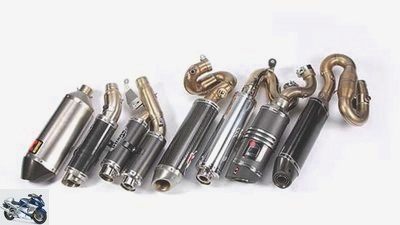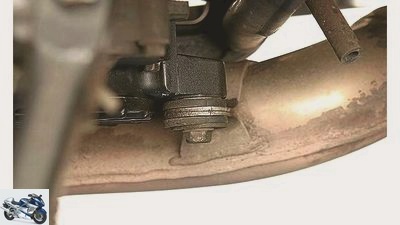Table of contents

Photos: mps-Studio
accesories
Exhaust & silencer
Mount the accessory exhaust
Mount the accessory exhaust
Sound engineering
The first major conversion on your own bike is often the muffler. Whether it should do more, weigh less, sound more robust or look better, is irrelevant for the workflow of the work steps.
Manuel Fuchs
05/06/2011
The table is richly set. The range of providers ranges from Akrapovic and BOS to Yoshimura and Zard, and a TuV-compatible alternative silencer is available for almost every motorcycle. Whether the ravages of time have gnawed the series part, whether the eye has seen enough or the ear has heard enough – it doesn’t matter. This is not about fundamental questions of taste, but about the technical part: How does the new bag get onto the motorcycle.
tool
We assume that the motorcycle is stable, dry and parked with sufficient working space. The new muffler is within easy reach and the range of tools includes at least the following items: ring and fork wrenches in sizes 8 to 17; Socket wrench with T-handle in 12, 13 and 14 or a ratchet with extension and corresponding sockets; Torque wrench, wire brush, emery paper, copper paste, spray oil / rust remover, a small hacksaw just in case, screwdriver and a spring hook to dismantle and reassemble the tension springs without injury.

archive
Small but important: a rubber bushing reduces the vibrations and thus protects the exhaust gaskets from wear.
Check seals
While you are busy at the moment: is your old exhaust still tight? Run the engine and check – caution, hot! – all seals in the system by hand, which you hold in front of it at a distance of two centimeters. If something blows through, you will notice it immediately. The sketch at the bottom right shows where seals can leak everywhere. If you notice a leak, don’t just tighten the screws on the outside! This only deforms the pipes and makes them even more leaky. Defective seals must be replaced, end of the announcement.
Dismantle the old pot
Let’s get closer to the core: Dismantle the old pot so that the new one fits:
1. Loosen the clamping screw of the exhaust clamp at the connection from the muffler to the exhaust manifold. The screw is usually as dirty as it is rusty, so first remove the coarsest dirt with a wire brush, spray with rust remover, let it work for a few minutes. Open the screw with an exactly fitting hexagonal socket.
2. Spray the nut and screw on the muffler (often on the passenger footrest) with rust remover. Open the nut with a spanner, counterhold the screw head with a nut.
3. Remove the muffler. If the package seal has crumbled, the muffler can usually be pulled off relatively easily. If the seal is older, it likes to stick in its seat. Spray with rust remover, grab the pot with both hands and pull it off with a slight twisting motion.

archive
Baked on: If the package seal is difficult to remove, a small saw and screwdriver can be useful. Then clean the sealing surfaces thoroughly with emery paper and a wire brush and smear them with copper paste.
Attach a new pot
1. Get a new exhaust gasket. This shiny silver-black sleeve is
similar to a gauze bandage and handled with care.
2. Dismantle the old package seal, if necessary help with a saw. Contact points
the exhaust gasket on the outside of the exhaust manifold pipe and in the clamping point
clean the muffler well. Thoroughly remove rust and remains of the seal with a steel brush and sandpaper.
3. Lubricate the new exhaust gasket inside and outside with copper paste and push it into its seat in the clamping point of the connecting pipe on the muffler all the way down to the stop. This has to be easy, nothing should jam – otherwise: pull the seal out again and widen the opening slightly until the pipe can be pushed open without force.
4. Push the muffler in line with the manifold pipe, do not tilt it (otherwise the seal will be damaged), push the muffler open with slight turning movements so that the rear retaining eyelet comes to rest on the retaining hole.
5. Position the clamp so that the hook engages in the cutout and the clamping point points backwards / downwards towards the tire. Screw in the screw and tighten to approx. 20 Nm.
6. Slide the washer onto the screw, insert the screw through the hole in the bracket, slide on another washer, screw on the nut and tighten to approx. 25 Nm.
Control – not just now
1. Visual inspection: Are all weld seams tight, are all rivets complete? Surface without dents, holes and rust?
2. Shake the muffler and hit it loosely with the heel of your hand: nothing should rattle. If so, a baffle plate has come loose on the inside. Then a new pot needs to be found – luckily the table is richly set.
Related articles
-
Ducati Multistrada V4 with Akrapovic exhaust ex works
Ducati 45 pictures Ducati 1/45 Ducati brings the new Multistrada with a V4 engine. Ducati 2/45 Ducati has made the Multistrada even more versatile….
-
Motorcycle exhaust systems from SR-Racing
fact 18th pictures fact 1/18 Sepp Bruckschlogl is the master of the pipes and head of SR-Racing. fact 2/18 Components of the silencer. fact 3/18 Shapes…
-
Exhaust tuning and performance comparison at Akrapovic
Bilski 27 pictures fact 1/27 Three parameters mainly determine the potential of a bend: the diameter of the pipes, their shape and length. Akrapovic 2/27…
-
Exhaust test Suzuki Bandit 1250-S
Jahn accesories Exhaust & silencer Exhaust test Suzuki Bandit 1250 / S Exhaust test Suzuki Bandit 1250 / S Band of robbers Holger Hertneck 08/14/2009…
-
Exhaust test Yamaha FZS 1000 Fazer
Jahn accesories Exhaust & silencer Exhaust test Yamaha FZS 1000 Fazer Exhaust test Yamaha FZS 1000 Fazer Sound appeal 17 Accessory silencers for the…
-
Product test: accessory silencer for BMW S 1000 RR
Photos: BMW accesories Exhaust & silencer Product test: accessory silencer for BMW S 1000 RR Product test: exhaust systems for BMW S 1000 RR What do…
-
Screwdriver tip exhaust system – Honda CB 750 Seven Fifty
Ralf Petersen 14th pictures Ralf Petersen 1/14 The starting point: a Honda CB 750 Sevenfifty for 850 euros, first registration February 1994. Ralf…
-
Technology: exhaust gas cleaning
motorcycles Technology: exhaust gas cleaning Technology: exhaust gas cleaning Scourer How clean is the F 650 GS really, asked MOTORRAD in issue 10. Now…
-
Wunderlich exhaust deflector: GS without roar
Wonderful 4th pictures Wonderful 1/4 The low-frequency roar of BMW R 1250 GS and R 1200 GS equipped with suitcases is often discussed by customers….
-
Conversion tips exhaust systems
Hanselmann 8th pictures Debus 1/8 In principle, there are two options when the exhaust is to be replaced. Here is a completely new system from Akrapovic,…